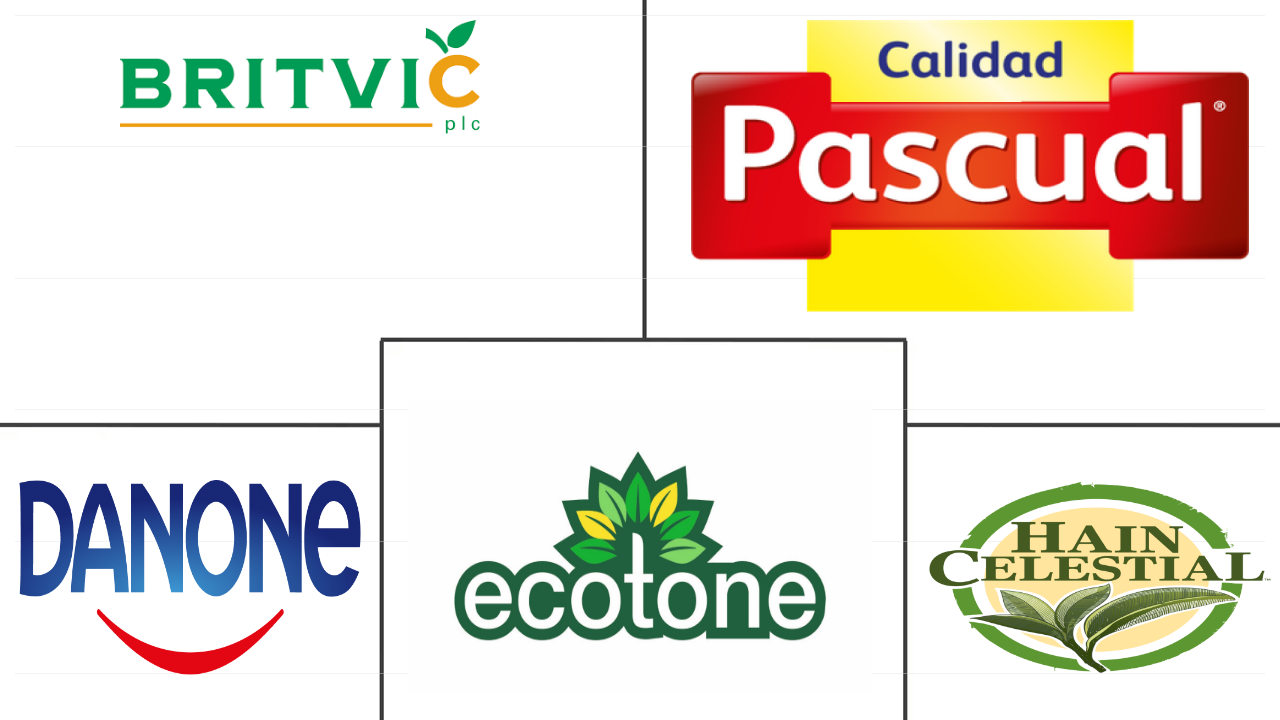Market Size of europe almond milk Industry
|
|
Study Period | 2017 - 2029 |
|
|
Market Size (2024) | USD 1.45 Billion |
|
|
Market Size (2029) | USD 2.89 Billion |
|
|
Largest Share by Distribution Channel | Off-Trade |
|
|
CAGR (2024 - 2029) | 14.73 % |
|
|
Largest Share by Country | Germany |
Major Players |
||

|
||
|
*Disclaimer: Major Players sorted in no particular order |
Europe Almond Milk Market Analysis
The Europe Almond Milk Market size is estimated at 1.45 billion USD in 2024, and is expected to reach 2.89 billion USD by 2029, growing at a CAGR of 14.73% during the forecast period (2024-2029).
1.45 Billion
Market Size in 2024 (USD)
2.89 Billion
Market Size in 2029 (USD)
14.67 %
CAGR (2017-2023)
14.73 %
CAGR (2024-2029)
Largest Market by Distribution Channel
97.42 %
value share, Off-Trade, 2023
The growth of the segment in the region is largely driven by the existence of an inviting place for customers to shop, as they are constantly drawn to make large purchases.
Largest Market by Country
22.57 %
value share, Germany, 2023

The increasing vegan population in the country with the wider acceptance of innovation in the sector including almond milk products is influencing the growth of the segment in the market.
Fastest-growing Market by Distribution Channel
14.80 %
Projected CAGR, Off-Trade, 2024-2029
The feasible localities of off-trade retail channels like convenience stores allow consumers to shop within minimal distances, making it a larger segment in the market.
Fastest-growing Market by Country
24.79 %
Projected CAGR, Russia, 2024-2029
Russia's major consumption of almond milk is driven by the rise in several individuals with lactose intolerance and its' increased health-beneficial factors.
Leading Market Player
33.97 %
market share, Danone SA, 2022

The presence of exhaustive product offerings along with a larger distribution network and a wider presence throughout the country has made Danone S.A. a leading market player.
Strong presence of supermarkets in the region is supporting the market growth
- The off-trade channel plays a major in the sales of almond milk in Europe. Among these, supermarkets and hypermarkets accounted for a majority share of almond milk sales during the study period. In 2022, these retail channels accounted for 61.7% of the value share. They have a strong position due to the wide selection of brands offered, considerable shelf space, and frequent price promotions.
- Compared to vegan milk, dairy milk prices have increased in UK supermarkets. In 2022, 1 L of cow milk cost USD 1.52 in major supermarkets in the United Kingdom, a 36% rise since January, whereas plant-based milk, including almond milk, cost USD 1.30 per liter.
- During the study period, convenience stores stood second in terms of the sales of almond milk, after supermarkets and hypermarkets. In 2022, the sales value of almond milk through convenience stores experienced a growth rate of 15.9% from 2020 to 2022. The major factor behind this growth was the ease of access and longer opening hours compared to modern stores.
- The on-trade channel is the fastest-growing retail channel in the European almond milk market, which is anticipated to grow by 41.8% in 2025 compared to 2022. Many leading restaurants in Europe use almond milk as an ingredient in cocktails, smoothies, coffees, and espresso-based drinks. Major coffee chains, including Costa Coffee, Starbucks, McCafe, and Caffe Nero, already offer almond milk. As of 2022, Costa Coffee was one of the leading coffee shop chains operating with more than 3,263 outlets across the region. Starbucks stood second with more than 2,556 stores.
The growing lactose-intolerant population and people with cow's milk allergies in the region significantly drive the almond milk market
- Rising health consciousness among consumers is the key factor driving the demand for dairy-free products, including almond milk, in Europe. In 2022, the almond milk market grew by a value of 14.2% compared to 2021. People are switching to almond milk due to its associated health benefits and the rising greenhouse gas emissions from the dairy industry. Consumers also opt for almond milk due to their increasing interest in fitness and health consciousness. In 2021, the number of members at gyms and health clubs in Europe reached 56.3 million, 2% higher than in 2020.
- The growing lactose-intolerant population and people with cow's milk allergies in the region significantly drive the almond milk market. In 2020, 32% of UK consumers stated that they had an intolerance to cow's milk and other dairy products. In 2021, around 0.77 million Germans aged 14 and over preferred lactose-free products. Almond milk is considered healthier than other non-dairy milk due to its calorie content. Rice milk has 120 calories, whereas almond milk has 40 calories.
- Across Europe, inflation is rising in many industries, including food, energy, and transportation. As a result, consumers are looking for more cost-effective ways to shop, thus cutting down on animal products, including dairy, and switching to plant-based milk. In 2020, nearly 12% of Spanish consumed almond milk almost every day. In countries like the United Kingdom and Germany, almond milk prices were cheaper than whole milk. A two-pint bottle of cow milk in the United Kingdom costs USD 1.58, whereas almond milk costs USD 1.35.
Europe Almond Milk Industry Segmentation
Off-Trade, On-Trade are covered as segments by Distribution Channel. Belgium, France, Germany, Italy, Netherlands, Russia, Spain, Turkey, United Kingdom are covered as segments by Country.
- The off-trade channel plays a major in the sales of almond milk in Europe. Among these, supermarkets and hypermarkets accounted for a majority share of almond milk sales during the study period. In 2022, these retail channels accounted for 61.7% of the value share. They have a strong position due to the wide selection of brands offered, considerable shelf space, and frequent price promotions.
- Compared to vegan milk, dairy milk prices have increased in UK supermarkets. In 2022, 1 L of cow milk cost USD 1.52 in major supermarkets in the United Kingdom, a 36% rise since January, whereas plant-based milk, including almond milk, cost USD 1.30 per liter.
- During the study period, convenience stores stood second in terms of the sales of almond milk, after supermarkets and hypermarkets. In 2022, the sales value of almond milk through convenience stores experienced a growth rate of 15.9% from 2020 to 2022. The major factor behind this growth was the ease of access and longer opening hours compared to modern stores.
- The on-trade channel is the fastest-growing retail channel in the European almond milk market, which is anticipated to grow by 41.8% in 2025 compared to 2022. Many leading restaurants in Europe use almond milk as an ingredient in cocktails, smoothies, coffees, and espresso-based drinks. Major coffee chains, including Costa Coffee, Starbucks, McCafe, and Caffe Nero, already offer almond milk. As of 2022, Costa Coffee was one of the leading coffee shop chains operating with more than 3,263 outlets across the region. Starbucks stood second with more than 2,556 stores.
| Distribution Channel | |||||||
| |||||||
| On-Trade |
| Country | |
| Belgium | |
| France | |
| Germany | |
| Italy | |
| Netherlands | |
| Russia | |
| Spain | |
| Turkey | |
| United Kingdom | |
| Rest of Europe |
Europe Almond Milk Market Size Summary
The Europe almond milk market is experiencing significant growth, driven by increasing health consciousness and a shift towards dairy-free products. Consumers are increasingly opting for almond milk due to its perceived health benefits, lower calorie content, and the rising environmental concerns associated with dairy production. The market is characterized by a strong presence in off-trade channels, particularly supermarkets and hypermarkets, which dominate sales due to their extensive brand offerings and promotional strategies. Convenience stores also contribute to the market's expansion, benefiting from their accessibility and extended operating hours. The on-trade channel is emerging as the fastest-growing segment, with major coffee chains incorporating almond milk into their offerings, further boosting its popularity.
The market's growth is further supported by the rising number of lactose-intolerant individuals and those with cow's milk allergies in Europe, who are turning to almond milk as a viable alternative. Economic factors, such as inflation, are prompting consumers to seek cost-effective shopping options, leading to a preference for plant-based milks like almond milk over traditional dairy products. The market is fragmented, with key players like Britvic PLC, Calidad Pascual SAU, Danone SA, Ecotone, and The Hain Celestial Group Inc. actively participating in product innovation and sustainable practices. The increasing popularity of veganism and changing dietary preferences are also contributing to the growing demand for almond milk, making it a staple in the conscious-eating movement across Europe.
Europe Almond Milk Market Size - Table of Contents
-
1. MARKET SEGMENTATION (includes market size in Value in USD and Volume, Forecasts up to 2029 and analysis of growth prospects)
-
1.1 Distribution Channel
-
1.1.1 Off-Trade
-
1.1.1.1 Convenience Stores
-
1.1.1.2 Online Retail
-
1.1.1.3 Specialist Retailers
-
1.1.1.4 Supermarkets and Hypermarkets
-
1.1.1.5 Others (Warehouse clubs, gas stations, etc.)
-
-
1.1.2 On-Trade
-
-
1.2 Country
-
1.2.1 Belgium
-
1.2.2 France
-
1.2.3 Germany
-
1.2.4 Italy
-
1.2.5 Netherlands
-
1.2.6 Russia
-
1.2.7 Spain
-
1.2.8 Turkey
-
1.2.9 United Kingdom
-
1.2.10 Rest of Europe
-
-
Europe Almond Milk Market Size FAQs
How big is the Europe Almond Milk Market?
The Europe Almond Milk Market size is expected to reach USD 1.45 billion in 2024 and grow at a CAGR of 14.73% to reach USD 2.89 billion by 2029.
What is the current Europe Almond Milk Market size?
In 2024, the Europe Almond Milk Market size is expected to reach USD 1.45 billion.

